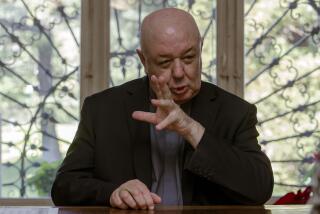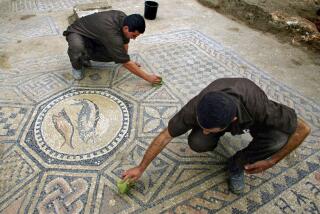Vatican’s Judaica Cache Links Two Faiths
- Share via
An exhibition of Hebrew manuscripts from the Vatican now on view at the Hebrew Union College Skirball Museum attempts to show that the historic chasm between Christians and Jews may not be as wide as many people believe.
“A Visual Testimony: Judaica From the Vatican Library” contains 57 manuscripts, some of them sumptuously illuminated, from the 8th through the 18th centuries. The downtown exhibit is meant to show the development of thought in Judaism, as well as the cultural and intellectual exchange between Christians and Jews throughout 1,000 years.
The rare materials, including Bibles and books on liturgy, Talmud, philosophy, mysticism, medicine and more, are part of the Vatican’s 800-piece collection of Judaica. Until the exhibit began its American tour last fall, these treasures had been accessible only to papal palace scholars.
“The spirit behind the exhibit came from the Second Vatican Council (1961-65) when a new openness to non-Catholic religions and a new era of Catholic-Jewish relations began,” said Skirball Museum Director Nancy Berman recently.
Among organizers’ goals, she said, were “to show that Jewish spiritual and intellectual development didn’t stop with the Bible,” to reveal the “beauty and creativity of the manuscripts,” and primarily, “to show that, in terms of scholarship, there was a cross-fertilization, an attempt to understand each other’s traditions, especially from Catholics to Jews. Some people think that little communication took place or that it was only hostile.”
The Jewish books, similar in style and purpose to Christian illuminated manuscripts, range in size from a 2-inch to a 2-foot-tall Bible. They include “Mahzor,” a 14th-Century High Holiday prayer book painted with tiny grotesque animals, and “Mishneh Torah,” a 15th-Century Jewish legal code by Moses Maimonides with jousting knights richly illustrated in gold leaf, lapis lazuli and other jewel-like hues. A synagogue service and a kosher slaughtering are shown elsewhere.
Also like their Christian counterparts, the Jewish books reflect regional differences, with illustrations ranging from delicate Florentine to bold architectural Spanish designs.
The Jewish scholars who wrote these manuscripts sometimes illuminated them as well. But because illustration “wasn’t a typical Jewish profession--like writing--they were often sent to professional book production houses to be finished by Christians,” Berman explained.
The Vatican has collected Judaica since it established its library in the 15th Century, which shows “the avid interest by Catholic scholars in Jewish thought,” Berman said. Interplay between Christians and Jews is evident in the similarities of their illuminated manuscripts, too. But the contents of the books in the exhibit seem to most powerfully demonstrate the cultural exchange.
For instance, “Biblical Commentaries by Richard and Andrew of St. Victor” is a Latin text written by two progressive 12th-Century Christian theologians. But both scholars consulted with Jews, and the book contains Jewish scriptural interpretations translated from Hebrew and a depiction of Ezekiel, a Hebrew prophet.
In “Postillae Perpetuae super Isaiam,” another Latin biblical commentary, the Christian Hebraist Nicholas of Lyra includes several translated comments of Rabbi Solomon ben Isaac of Troyes, known as Rashi, one of history’s greatest rabbis. Similarly, Christian Renaissance scholars translated a “Commentary on Genesis,” by Jewish scholar Philo of Alexandria, from Greek to Latin.
With the process working in reverse, “Homiliae” by the 18th-Century Pope Clement XI provides a Hebrew translation of many of the holy man’s sermons.
The groundwork for the exhibition, through April 10, was set by Rabbi Philip Hiat, special assistant to the president of the Union of American Hebrew Congregations, the parent body of the Reform Jewish movement.
In mid-1984, Hiat obtained an invitation from the National Conference of Catholic Bishops to view the Vatican’s Judaica collections. In 1985, he returned to Rome with a delegation that included Michael Signer, professor of Jewish history at Hebrew Union College, and Philip E. Miller, librarian at the college’s New York campus. Last year, Miller and Signer went to Rome to make the final selections for the exhibit, organized by the Center for the Fine Arts in Miami.
“It’s a very esoteric show,” Berman said. “But I think it contains some powerful notions and facts in history that we don’t normally think about. It helps break down stereotypes about the absolute exclusivity of Jews and Christians.”
More to Read
The biggest entertainment stories
Get our big stories about Hollywood, film, television, music, arts, culture and more right in your inbox as soon as they publish.
You may occasionally receive promotional content from the Los Angeles Times.










